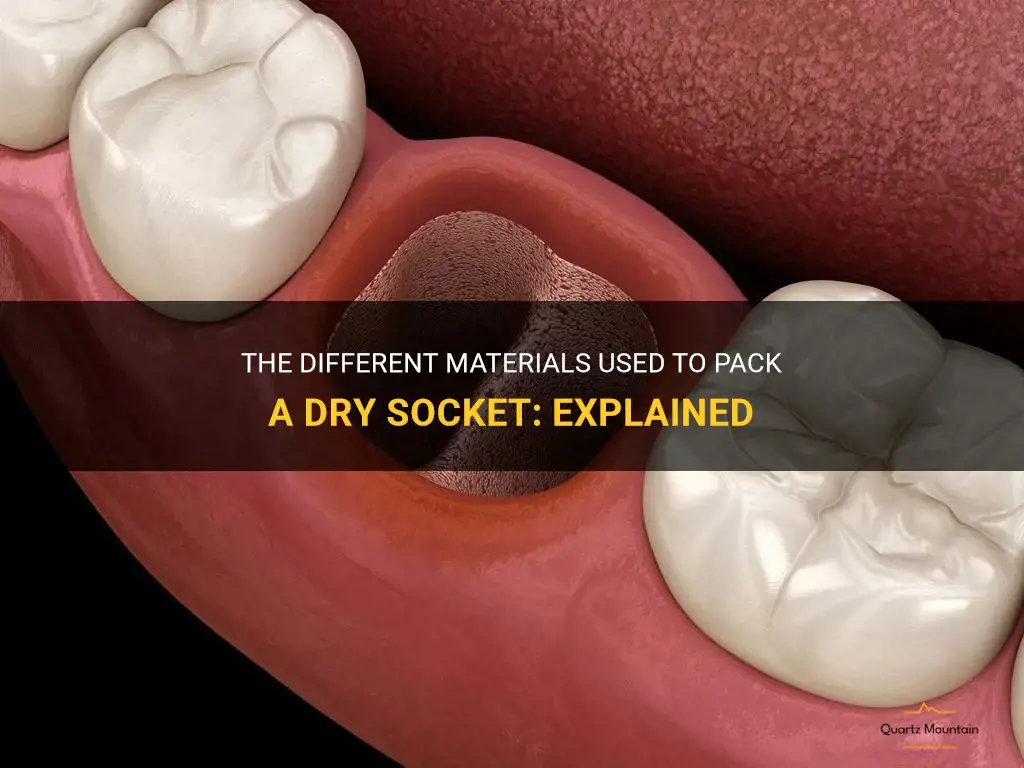
Dry socket is a painful condition that can occur after a tooth extraction. It happens when the blood clot that normally forms in the socket is dislodged or dissolves, leaving the bone and nerves exposed. To help alleviate the discomfort and promote healing, dentists often pack the socket with various materials. In this article, we will explore the different materials used to pack a dry socket and how they aid in the recovery process. From medicated dressings to natural remedies, we will delve into the fascinating world of dental packing and its essential role in oral health.
What You'll Learn
- What materials are commonly used to pack a dry socket?
- How does the packing material help to heal a dry socket?
- Are there any specific types of packing material that are more effective for treating dry sockets?
- Can the packing material cause any side effects or complications?
- How long does the packing material typically need to stay in the dry socket for effective healing?

What materials are commonly used to pack a dry socket?
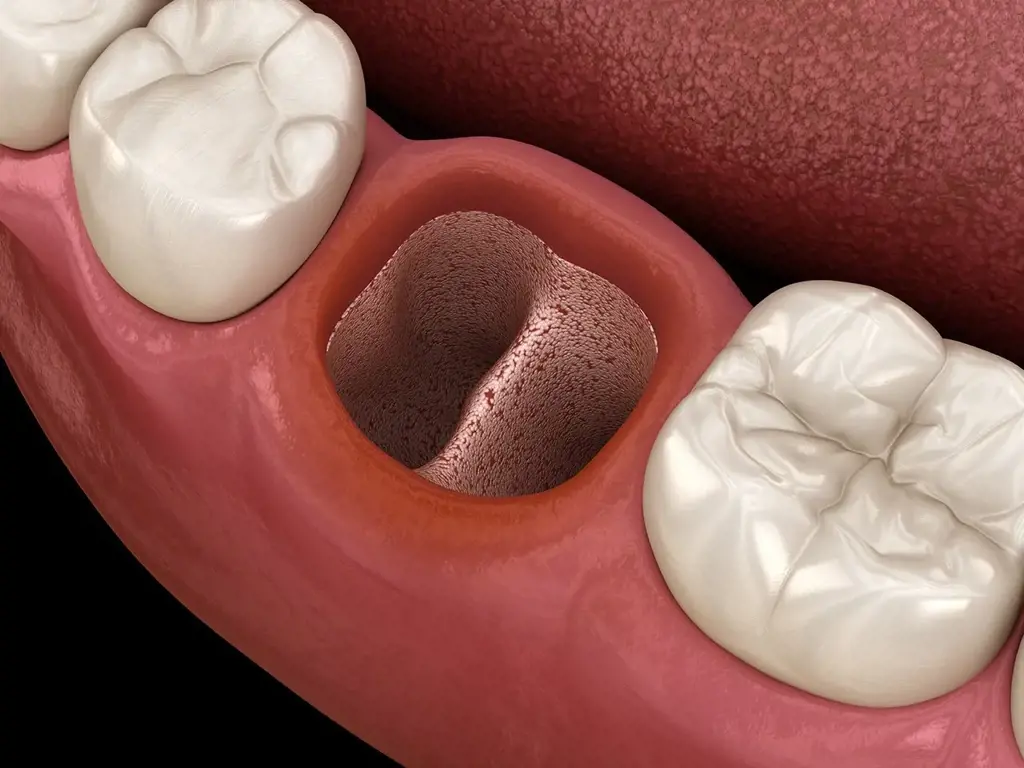
Dry socket, also known as alveolar osteitis, is a painful condition that can occur after tooth extraction. It happens when the blood clot that typically forms in the tooth socket after extraction is dislodged or dissolved, leaving the underlying bone and nerves exposed. To promote healing and alleviate pain, it is common to pack the dry socket with certain materials.
The choice of materials used to pack a dry socket depends on a variety of factors, including the severity of the condition and the preferences of the dentist or oral surgeon. Some commonly used materials include:
- Eugenol-based dressings: Eugenol is a natural compound found in cloves that has analgesic (pain-relieving) and antiseptic properties. Eugenol-based dressings, such as Alvogyl or dry socket paste, are frequently used to pack dry sockets. These dressings usually contain a combination of eugenol, zinc oxide, and other ingredients. Eugenol helps to alleviate pain and reduce inflammation, while the other components provide a protective barrier to promote healing.
- Paste with iodoform: Iodoform is a yellowish powder that has antimicrobial properties. It is often combined with other materials, such as bismuth subnitrate, to form a paste that can be used to pack dry sockets. The paste acts as a barrier to protect the exposed bone and nerves, while the iodoform helps to prevent infection and promote healing.
- Gauze impregnated with medicated solutions: Another option for packing dry sockets is to use gauze that has been impregnated with medicated solutions. These solutions can contain various ingredients, such as eugenol, iodoform, or antibiotics. The gauze is placed directly in the dry socket to provide a protective barrier and deliver medication to the affected area.
- Platelet-rich fibrin (PRF): Platelet-rich fibrin is a concentrate of platelets and growth factors derived from the patient's own blood. It is typically obtained by drawing a small amount of blood from the patient and processing it to isolate the platelets. PRF can be used to pack dry sockets, as it promotes tissue regeneration and accelerates healing. It also has antimicrobial properties, which can help prevent infection.
- Antibiotic gels or pastes: In cases where there is a high risk of infection or if infection is already present, antibiotic gels or pastes may be used to pack dry sockets. These gels or pastes contain antibiotics, such as metronidazole or clindamycin, which help to eliminate bacteria and prevent further infection.
It is important to note that the choice of material for packing dry sockets should be made by a dental professional. They will carefully evaluate the individual case and determine the most appropriate treatment plan. Additionally, patients should follow post-extraction care instructions provided by their dentist or oral surgeon to help prevent the development of dry sockets and promote proper healing.
The Essential Checklist: Avoiding Commonly Forgotten Items when Packing
You may want to see also

How does the packing material help to heal a dry socket?
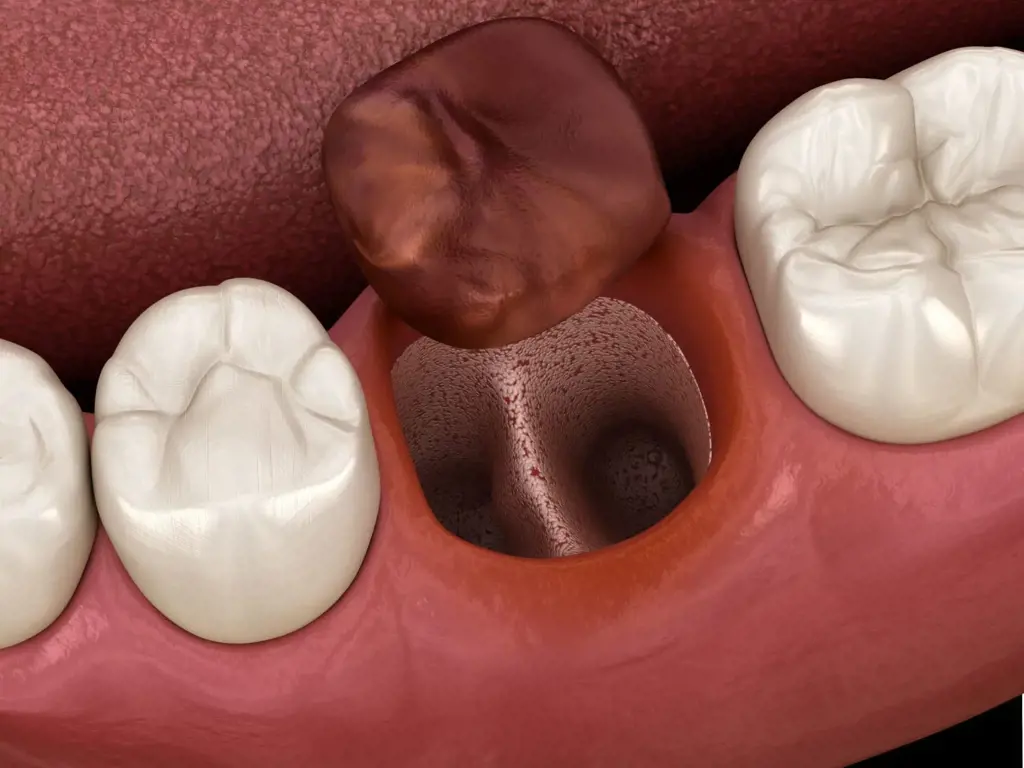
Dry socket, also known as alveolar osteitis, is a painful complication that can occur after a tooth extraction. It happens when the blood clot that is supposed to form in the socket after the extraction becomes dislodged or dissolves. This leaves the underlying bone and nerves exposed, leading to intense pain and further delayed healing.
One of the main ways to treat a dry socket is by using a packing material. This material is usually placed directly into the socket after the extraction procedure, providing a protective barrier over the exposed bone and nerves. Let's take a closer look at how this packing material helps in the healing process.
- Promotes Blood Clot Formation: One of the primary functions of the packing material is to facilitate the formation of a new blood clot in the socket. The material acts as a scaffold, allowing the blood to coagulate and form a protective barrier over the exposed bone. This clot is essential for the healing process, as it helps stimulate the growth of new tissue and provide a foundation for the development of a new socket.
- Protects the Socket: The packing material acts as a physical barrier between the socket and external irritants, such as food particles and bacteria. By keeping the socket protected, it minimizes the risk of further infection or irritation. This protection is crucial for the healing process, as any additional damage or infection can further delay the natural healing of the socket.
- Reduces Pain and Discomfort: The packing material provides cushioning and support to the exposed bone and nerves, alleviating the intense pain associated with a dry socket. It acts as a barrier between these sensitive structures and the oral environment, reducing the irritation and inflammation that contribute to the pain. By minimizing pain and discomfort, the packing material allows the patient to eat, speak, and carry out their daily activities with more ease while the socket heals.
- Facilitates Tissue Regeneration: The packing material also promotes the growth and regeneration of new tissue in the socket. It creates an environment that is conducive to healing, allowing the body to produce new cells and blood vessels. Additionally, some packing materials contain medicated substances that promote tissue healing, reduce inflammation, and prevent infection. These properties further aid in the healing of the dry socket.
It is important to note that the type of packing material used can vary depending on the dentist's preference and the specific needs of the patient. Common packing materials include gauze, medicated dressings, or collagen-based materials. The dentist will determine the most suitable option based on factors such as the severity of the dry socket and the patient's overall oral health.
In conclusion, the use of packing material plays a crucial role in the healing of a dry socket. By promoting blood clot formation, protecting the socket, reducing pain, and facilitating tissue regeneration, the packing material aids in the natural healing process and promotes a faster recovery. If you experience the symptoms of a dry socket after a tooth extraction, it is essential to seek prompt dental care to prevent further complications and ensure a successful healing process.
Essential Items to Pack for the Tankwa Camino Adventure
You may want to see also

Are there any specific types of packing material that are more effective for treating dry sockets?
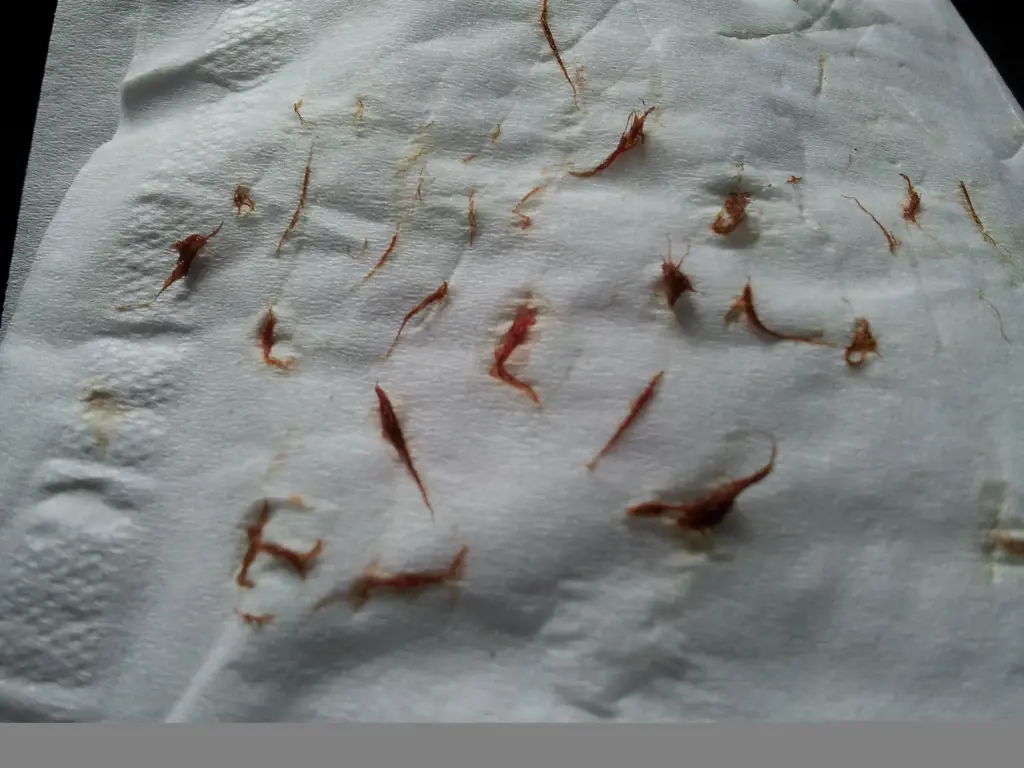
Dry socket is a common complication that can occur after a tooth extraction. It is characterized by severe pain in the socket where the tooth used to be and is typically caused by the blood clot dislodging or breaking down before the socket has a chance to heal. One treatment option for dry socket is the use of packing material to help promote healing and alleviate pain. In this article, we will discuss the different types of packing materials that are used for treating dry sockets and which ones are more effective.
There are several types of packing materials that can be used for treating dry sockets. Some of the most commonly used options include eugenol-soaked dressings, medicated gauze, and collagen sponges. Let's look at each of these in more detail:
- Eugenol-soaked dressings: Eugenol is a natural compound found in cloves and is known for its analgesic and antiseptic properties. Eugenol-soaked dressings are often used to provide pain relief and reduce infection in dry sockets. These dressings are typically made by saturating a piece of gauze with eugenol and placing it in the socket. The eugenol helps to numb the area and reduce inflammation, while also promoting healing.
- Medicated gauze: Medicated gauze can also be used as a packing material for dry sockets. These gauze dressings are typically soaked in a solution containing an antibiotic, such as chlorhexidine, as well as a topical analgesic, such as lidocaine. The antibiotic helps to prevent infection, while the analgesic provides pain relief. Medicated gauze dressings are often changed every few days to ensure that the socket remains clean and free of bacteria.
- Collagen sponges: Collagen is a protein found in the connective tissues of animals, including humans. Collagen sponges are often used as a packing material for dry sockets due to their ability to promote healing. These sponges are typically soaked in a solution containing antibiotics and placed in the socket. The collagen helps to stimulate the growth of new tissue and blood vessels, while the antibiotics prevent infection.
In terms of effectiveness, the choice of packing material will depend on several factors, including the severity of the dry socket and the individual patient's needs. However, research has shown that eugenol-soaked dressings and medicated gauze tend to be more effective in providing pain relief and reducing infection compared to collagen sponges. This is likely due to the analgesic and antiseptic properties of eugenol and the added benefit of antibiotics in medicated gauze dressings.
It is important to note that the use of packing material for dry socket treatment should always be done under the guidance of a dentist or oral surgeon. They will be able to assess the severity of the dry socket and determine which packing material would be most appropriate. Additionally, it is crucial to follow the dentist's instructions for changing the packing material and maintaining proper oral hygiene to ensure optimal healing.
In conclusion, there are several types of packing materials that can be used for treating dry sockets, including eugenol-soaked dressings, medicated gauze, and collagen sponges. While all of these options can be effective, eugenol-soaked dressings and medicated gauze tend to provide better pain relief and infection prevention. However, the choice of packing material should be based on the individual patient's needs and should always be done under the guidance of a dental professional.
Essential Gear for Backcountry Skiing: What to Pack for a Successful Adventure
You may want to see also

Can the packing material cause any side effects or complications?
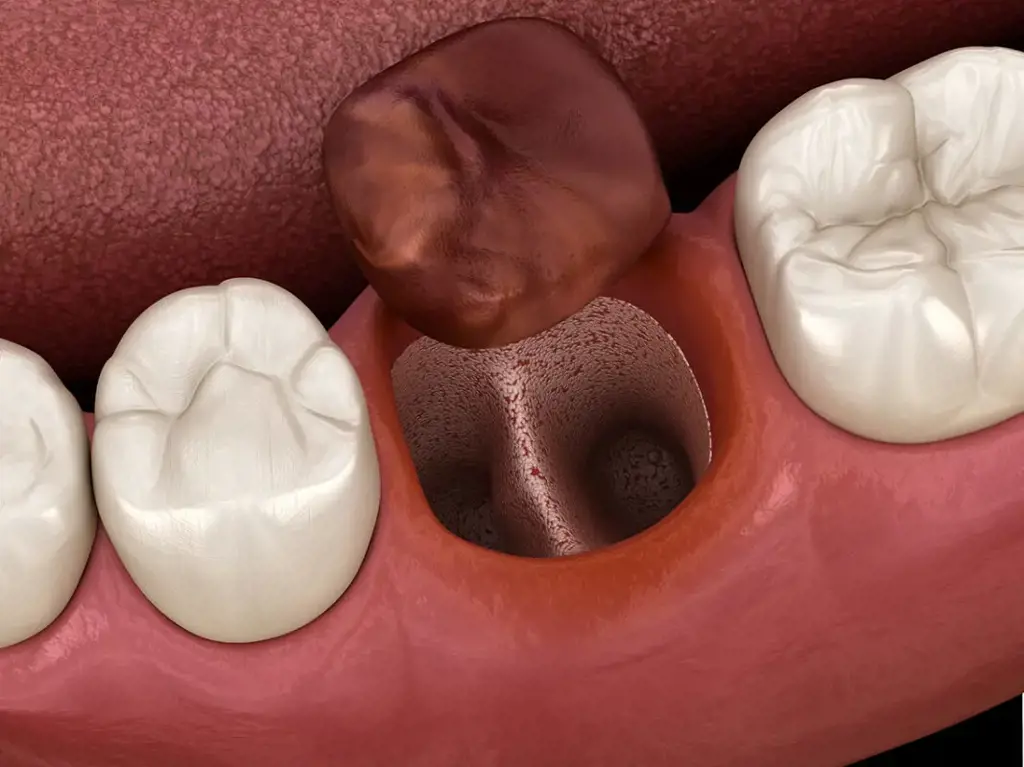
When it comes to packing material, it is important to consider the potential side effects and complications that may arise. While packing material is designed to protect and cushion items during transport, it's essential to use appropriate packaging materials and techniques to avoid any adverse effects.
One of the main concerns with packing material is the potential for allergens. Some individuals may have allergies to certain materials such as bubble wrap, packing peanuts, or Styrofoam. These materials can release small particles into the air, which may trigger an allergic reaction in sensitive individuals. It is crucial to be aware of any allergies and choose packing materials accordingly. There are alternative packing materials available that are hypoallergenic and do not contain any potentially harmful substances.
In addition to allergens, some packing materials can be harmful if ingested. For example, small children or pets may accidentally swallow packing peanuts or foam, leading to choking or digestive issues. It is important to keep these packing materials out of reach of children and pets to prevent such complications.
Another consideration when using packing material is the environmental impact. Many packing materials, such as Styrofoam, are not biodegradable and can contribute to pollution and waste. To mitigate these effects, it is beneficial to choose eco-friendly packing materials, such as biodegradable peanuts or recyclable paper.
Improper use of packing materials can also result in complications. Overpacking an item with too much cushioning material can make the package bulky and increase shipping costs. On the other hand, inadequate cushioning can lead to damage during transport. It is crucial to strike a balance, using enough packing material to protect the item without overdoing it.
The packing material chosen should also be compatible with the item being packed. Fragile items, such as glassware or electronics, require materials that offer adequate protection. Bubble wrap or foam sheets are often the go-to for delicate items, as they provide cushioning and shock absorption. Choosing the right packing material for the specific item being shipped can help minimize the risk of damage.
To ensure the proper use of packing materials, it is essential to follow specific guidelines and best practices. For example, bubble wrap should be securely taped around the item to ensure it stays in place during transport. Similarly, foam sheets should be wrapped tightly around fragile items to provide maximum protection. Following these guidelines can help avoid complications and ensure the item arrives safely at its destination.
In conclusion, packing material can potentially cause side effects or complications if not used properly. Allergies, ingestion hazards, environmental impact, and improper use are some of the concerns to be aware of. By choosing appropriate materials, considering specific item requirements, and following best practices, the risks can be minimized, ensuring safe and secure transport.
Essential Packing Guide for a Memorable Christmas Cruise
You may want to see also

How long does the packing material typically need to stay in the dry socket for effective healing?
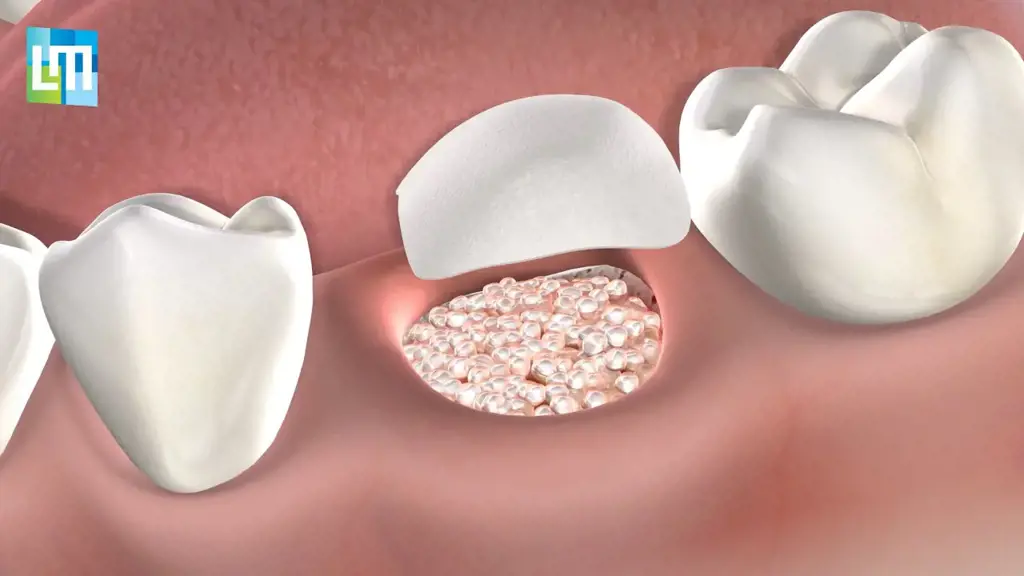
Dry socket is a common condition that can occur after tooth extraction. It is characterized by severe pain in the socket where the tooth used to be and delayed healing. To help promote healing and relieve pain, dentists often place a packing material, such as a medicated dressing, in the socket. But how long does this packing material typically need to stay in the dry socket for effective healing? Let's find out.
The duration for which the packing material needs to stay in the dry socket can vary depending on several factors. The severity of the dry socket and the individual's healing response are important factors to consider. In general, the packing material should be left in place for about 3-5 days for effective healing.
During the initial 24-48 hours after tooth extraction, the blood clot that forms in the socket acts as a natural barrier and protects the underlying bone and tissues. If this blood clot becomes dislodged or dissolves prematurely, it can result in a dry socket. The packing material helps to promote healing by providing a protective barrier and reducing pain. It also helps prevent bacterial infection, which can further delay healing.
When the packing material is placed, it is important to follow proper oral hygiene practices to ensure adequate healing. This includes gentle rinsing with warm salt water or an antimicrobial mouthwash, avoiding smoking and sucking on straws, and maintaining a soft diet. These measures can help minimize the risk of dislodging the packing material and promote healing.
After the initial 3-5 days, your dentist will remove the packing material and evaluate the healing progress. If the socket has healed well, further treatment may not be necessary. However, if there are signs of infection or delayed healing, additional measures may be taken, such as irrigating the socket with antimicrobial solutions or placing a different type of dressing.
It is important to note that every individual's healing process is unique, and the duration for which the packing material needs to stay in the dry socket may vary. It is crucial to follow your dentist's instructions and attend any follow-up appointments to ensure proper healing.
In conclusion, the packing material in a dry socket typically needs to stay in place for about 3-5 days for effective healing. This duration allows the socket to be protected and promotes proper healing. However, it is important to consult with your dentist for personalized instructions and to address any concerns or complications that may arise during the healing process. By following proper dental care practices, you can minimize the risk of dry socket and promote optimal healing after tooth extraction.
Essential Items to Pack for the Hospital: A Comprehensive Guide by BabyCenter
You may want to see also
Frequently asked questions
When treating a dry socket, dentists typically use a special dressing called medicated packing material. This material is often made from clove oil, zinc oxide, and eugenol, which can help alleviate pain and promote healing.
The medicated packing material used for dry sockets acts as a soothing barrier between the exposed bone and the oral environment. It provides pain relief by numbing the area and helps protect the socket from further irritation or infection.
No, the packing material is typically not left in the socket permanently. It serves as a temporary measure to promote healing and relieve pain. In most cases, the dentist will remove and replace the packing material during follow-up visits until the socket has fully healed.
The length of time the packing material stays in the socket can vary depending on the individual's healing process and the severity of the dry socket. Generally, the packing material is changed every few days or as needed until the socket has healed sufficiently.
It is not recommended to remove the packing material on your own. The dentist will have the necessary tools and expertise to safely remove and replace the packing material as needed. Removing it yourself can disrupt the healing process and potentially lead to complications.







